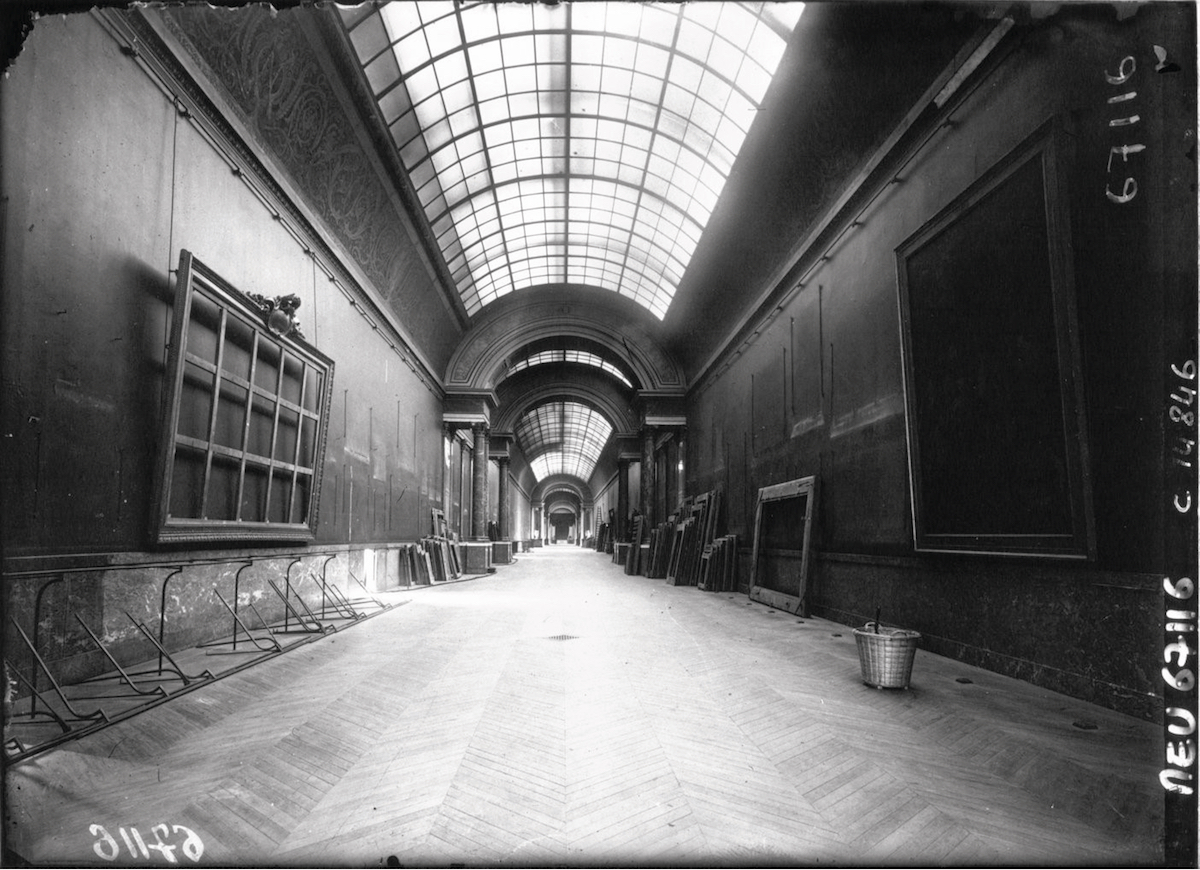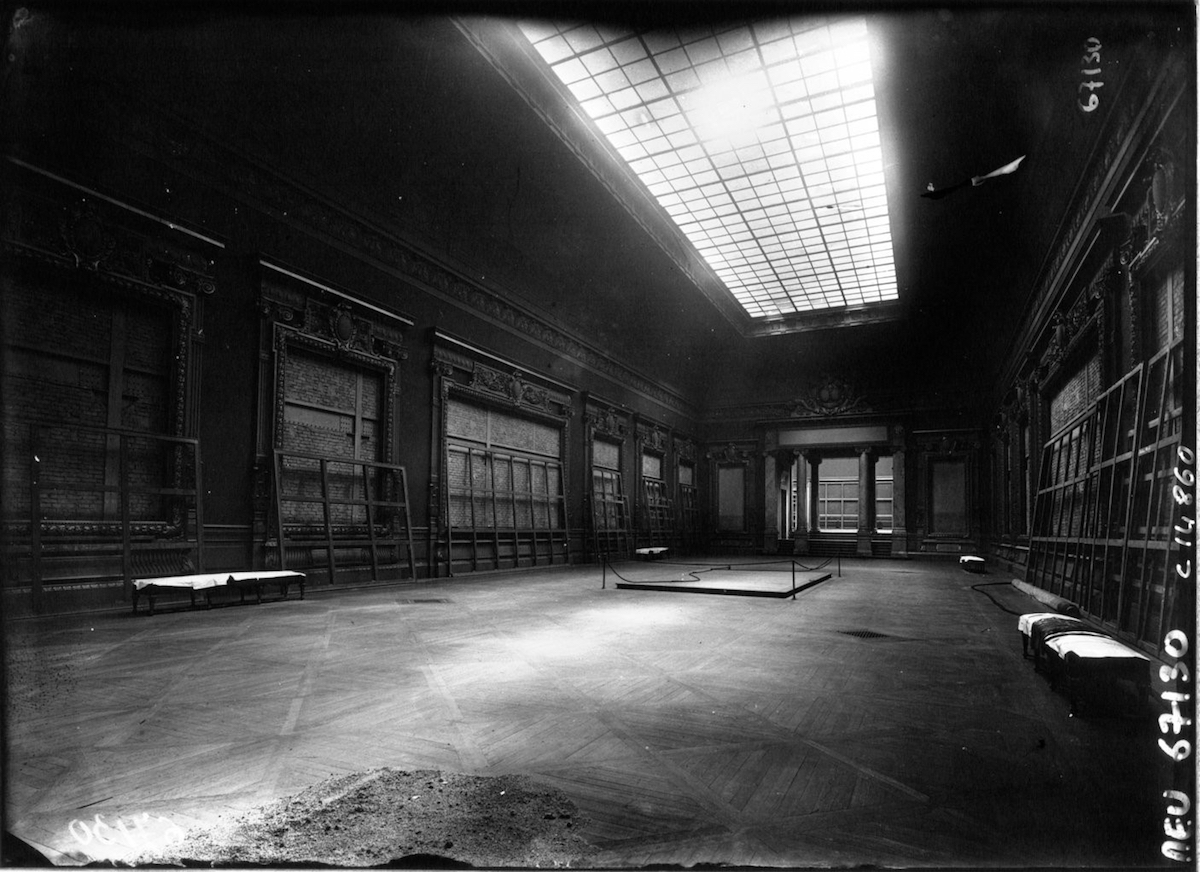Fraternité
by Guillaume Kientz

Grande Galerie of the Musée du Louvre. 1918. Bibliothèque nationale de France, Paris.
Every year in Paris, towards the middle of the month of November, the little world of art moves to the rhythm of Paris Tableau: the city’s Old Masters fair, which brings together dealers, collectors, curators like myself, and art lovers from far beyond France. We come together in November — though for the last time, we learned this year; Paris Tableau is being absorbed in 2016 into the larger Biennale des Antiquaires — to share our enthusiasms (or doubts) about paintings we see, to learn about our colleagues’ projects and discoveries, and to swap tittle-tattle or indiscretions about the people we know. Like any fair, this one is accompanied by major exhibition openings and minor ones, cocktails and dinners: a chance to disconnect even further from the world outside and fall into recondite conversations about subjects that perhaps only fifty people find interesting and only a dozen have mastered.
I was at one of those dinners on Friday, November 13. Like all the guests I left my coat in the cloakroom, and left my phone in my coat — such that it was only after midnight, as I was leaving, that the world outside made itself known to us again. And in the world outside, that night, there was the smell of fear and death.
I had dozens of missed calls, just as many voicemails, too many text messages to count. In the taxi, the voices on the radio spoke of “war,” of a “state of emergency.” Helicopter blades whirred their deafening, tormenting whir. Sirens blared — sirens that I would have paid no attention to in other circumstances, but which became unbearably distressing now that urban guerrilla warfare, so it seemed, was capable of making anyone, anywhere, a victim. I couldn’t even be sure that the taxi would agree to drive near the neighborhood where, so the radio said, the siege was still going on.
The next day was Saturday, and for most Parisians the start of the weekend would have offered a welcome pretext to stay home — out of fear, maybe, or else out of a desire for calm. But for those of us who work in museums, Saturday is a trading day like any other: one of the busier ones, in fact. Would the Louvre open? Would it be the next target, for all we knew? A few weeks before the attacks was the French premiere of Francofonia, by the Russian filmmaker Alexander Sokurov, and its images of the Louvre during the Occupation came back to me, telescoping into the present. The terrorists chose a concert hall as the principal site of their massacre, and we should not discount that culture can also be a victim of violence. Art can mitigate pain, art can offer serenity and even hope, and that weekend I was desperate to go to the closed museum, so that I and other visitors could come together to behold the kind of beauty that makes the worst a bit more bearable. But art also describes — and at its best embodies — an open conception of identities, of relations among diverse civilizations and faiths. It was as if the attacks of November 13 had burst an airtight bubble, a bubble I felt guilty for having floated in. Art did not offer an escape; art placed me at the heart of the situation, so close to its heart I couldn’t see clearly.

Photo courtesy of Agence Meurisse and Bibliothèque nationale de France, Paris.
My office is located in the riverside wing of the Palais du Louvre, right next to the Pavillon de Flore on the southwest corner. To reach the paintings department you can go straight through the Porte des Lions, the small entrance along the Seine, or you can get there via the galleries of the museum’s Denon wing. The Louvre had remained closed all weekend, and that Monday I wanted — I needed — to spend some time with the paintings before seeing my colleagues, with whom I would exchange a few pleasantries at once unoriginal and deeply sincere. I needed the paintings to assure me that all was well, at least here in the galleries; I wanted to see something unshakable, something that would not fail. The museum as haven, in other words, and the paintings as a salve for a soul in mourning. It must have been 10 o’clock. The museum was scheduled to reopen at 1 in the afternoon.
I love the Louvre when it’s empty, like every curator, for its charm more than for our privilege. But on that first day back in the museum, its empty galleries, vast and silent and deaf, felt unbearable to me. The paintings needed people, and vice versa. I decided to take a few photos, details of some of the most famous works in our collection, and posted them online: Murillo’s quiet, elegant Beggar, and Ribera’s Saint John, with his gaze full of hope and faith. It was a way to remind the outside world that while our institutions may be in danger, the masterpieces are still here. And to remember also what beauty can do, how it can bring us together, how it can calm us in difficult times. To remember how art tells history, a story of humanity capable of making great things, a story that so many of us wanted to hear that morning of Monday, November 16.
I hardly had time to make it back to my office before the Louvre’s entire staff was called to a briefing in the museum’s auditorium. The director’s words were somber, professional, reassuring too, and prompting all of us to remember the museum’s mission and our collective responsibility in such awful circumstances. At the end of the meeting, we all assembled under I.M. Pei’s massive glass pyramid. We observed a minute of silence, along with the rest of the nation. After which, timidly and then with more conviction, some members of the Louvre sang the first words of “La Marseillaise.” By the end, we were all singing, the whole staff, and by the time we all got back to our respective posts, with lumps in our throats and eyes still damp, the doors opened and the first visitors arrived. We watched, with relief, as the museum worked its magic; only the next week would we notice the decline in attendance. A few words from the national anthem still swam in our heads: “To arms, citizens....” But Aux arts, citoyens! would be a better rallying cry.